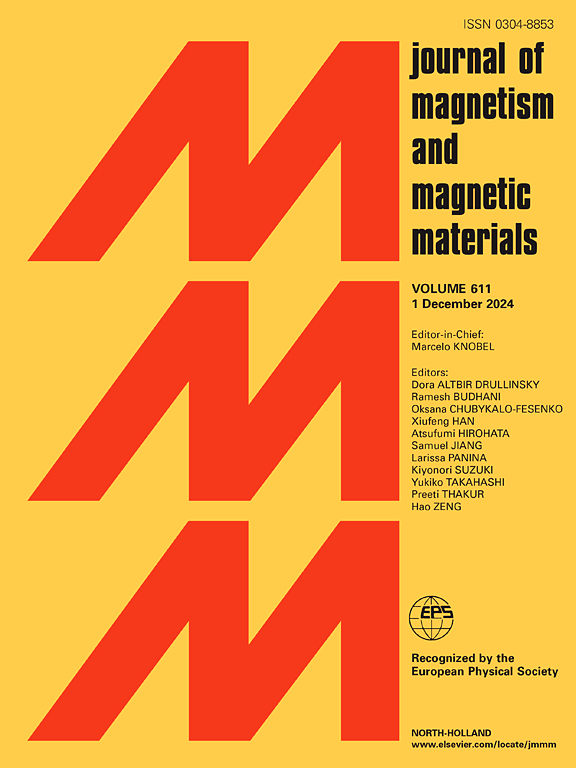Broadband tunable YIG film resonator with high loaded-Q and spurious mode suppression
IF 3
3区 材料科学
Q3 MATERIALS SCIENCE, MULTIDISCIPLINARY
引用次数: 0
Abstract
In this work, a broadband tunable high load factor () resonator based on yttrium iron garnet (YIG) films is proposed. Single-crystal YIG wafers were prepared on [111] crystal-oriented GGG substrates by liquid phase epitaxy (LPE) technique, and the samples were thinned to 100 um by chemical–mechanical polishing process to obtain excellent crystal quality with magnetic resonance linewidths as low as 1.8 . The resonator structure consists of an alumina ceramic substrate, a coplanar waveguide (CPW), and an open resonance ring (SRR). The CPW is used to excite magnetic resonance in the YIG film, and placing the YIG film on the backside of the CPW effectively enhances the uniformity of the microwave field, while the SRR structure further improves the uniformity of the magnetic field distribution. Experimental results demonstrate that the resonator exhibits excellent performance in the 5–25 GHz tuning range, with parameters better than −5.2 dB, values above 700 and the maximum figure of merit (FOM) is 17.21 at 14 GHz. In addition, the resonator successfully suppresses the higher-order spurious modes and maintains good spectral characteristics, which is promising for the application in the field of ultra-wideband tunable devices and microwave systems.
宽带可调谐YIG薄膜谐振器,具有高负载q和杂散模式抑制
本文提出了一种基于钇铁石榴石(YIG)薄膜的宽带可调谐高负载因数(QL)谐振器。采用液相外延(LPE)技术在[111]晶体取向的GGG衬底上制备了单晶YIG晶片,并通过化学机械抛光工艺将样品薄至100 um,获得了优异的晶体质量,其磁共振线宽低至1.8 Oe。谐振腔结构由氧化铝陶瓷衬底、共面波导(CPW)和开放谐振环(SRR)组成。利用CPW在YIG膜中激发磁共振,将YIG膜放置在CPW的背面,有效增强了微波场的均匀性,而SRR结构进一步提高了磁场分布的均匀性。实验结果表明,该谐振器在5-25 GHz调谐范围内表现出优异的性能,S11参数优于- 5.2 dB, QL值大于700,14 GHz时的最大优值(FOM)为17.21。此外,该谐振器成功地抑制了高阶杂散模式,并保持了良好的频谱特性,在超宽带可调谐器件和微波系统领域具有广阔的应用前景。
本文章由计算机程序翻译,如有差异,请以英文原文为准。
求助全文
约1分钟内获得全文
求助全文
来源期刊

Journal of Magnetism and Magnetic Materials
物理-材料科学:综合
CiteScore
5.30
自引率
11.10%
发文量
1149
审稿时长
59 days
期刊介绍:
The Journal of Magnetism and Magnetic Materials provides an important forum for the disclosure and discussion of original contributions covering the whole spectrum of topics, from basic magnetism to the technology and applications of magnetic materials. The journal encourages greater interaction between the basic and applied sub-disciplines of magnetism with comprehensive review articles, in addition to full-length contributions. In addition, other categories of contributions are welcome, including Critical Focused issues, Current Perspectives and Outreach to the General Public.
Main Categories:
Full-length articles:
Technically original research documents that report results of value to the communities that comprise the journal audience. The link between chemical, structural and microstructural properties on the one hand and magnetic properties on the other hand are encouraged.
In addition to general topics covering all areas of magnetism and magnetic materials, the full-length articles also include three sub-sections, focusing on Nanomagnetism, Spintronics and Applications.
The sub-section on Nanomagnetism contains articles on magnetic nanoparticles, nanowires, thin films, 2D materials and other nanoscale magnetic materials and their applications.
The sub-section on Spintronics contains articles on magnetoresistance, magnetoimpedance, magneto-optical phenomena, Micro-Electro-Mechanical Systems (MEMS), and other topics related to spin current control and magneto-transport phenomena. The sub-section on Applications display papers that focus on applications of magnetic materials. The applications need to show a connection to magnetism.
Review articles:
Review articles organize, clarify, and summarize existing major works in the areas covered by the Journal and provide comprehensive citations to the full spectrum of relevant literature.
 求助内容:
求助内容: 应助结果提醒方式:
应助结果提醒方式:


